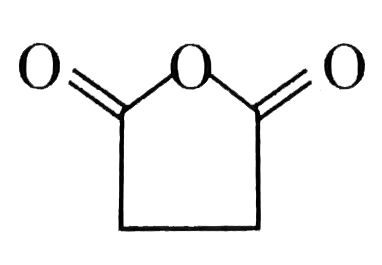When diethyl cadmium [(C2H5)2Cd] is treated with acetyl chloride [CH3COCl], the main product likely to be:
Acetone
Methyl ethyl ketone
Diethyl ketone
Acetaldehyde
The correct Answer is:B
To solve the question regarding the reaction of diethyl cadmium with acetyl chloride, we can follow these steps:
Step 1: Identify the Reactants
We have diethyl cadmium, which is represented as (C2H5)2Cd, and acetyl chloride, represented as CH3COCl.
Step 2: Understand the Reaction Mechanism
Diethyl cadmium acts as a nucleophile due to the presence of the alkyl groups. In this case, the ethyl groups (C2H5) will attack the carbonyl carbon of acetyl chloride. The carbonyl carbon in acetyl chloride is electrophilic because of the presence of the electronegative chlorine atom.
Step 3: Nucleophilic Attack
When the nucleophile (ethyl group from diethyl cadmium) attacks the carbonyl carbon of acetyl chloride, a tetrahedral intermediate is formed. This intermediate has the structure CH3C(OH)(C2H5)Cl.
Step 4: Elimination of Chlorine
In the next step, the chlorine atom (which is a good leaving group) will leave, resulting in the formation of a ketone. The oxygen will carry a negative charge, which will stabilize the structure.
Step 5: Final Product Formation
After the elimination of chlorine, the resulting product will be CH3C(=O)C2H5, which is methyl ethyl ketone (also known as 3-pentanone).
Conclusion
The main product formed when diethyl cadmium is treated with acetyl chloride is methyl ethyl ketone.
Final Answer
The correct answer is methyl ethyl ketone.
---
We have diethyl cadmium, which is represented as (C2H5)2Cd, and acetyl chloride, represented as CH3COCl.
Diethyl cadmium acts as a nucleophile due to the presence of the alkyl groups. In this case, the ethyl groups (C2H5) will attack the carbonyl carbon of acetyl chloride. The carbonyl carbon in acetyl chloride is electrophilic because of the presence of the electronegative chlorine atom.
When the nucleophile (ethyl group from diethyl cadmium) attacks the carbonyl carbon of acetyl chloride, a tetrahedral intermediate is formed. This intermediate has the structure CH3C(OH)(C2H5)Cl.
In the next step, the chlorine atom (which is a good leaving group) will leave, resulting in the formation of a ketone. The oxygen will carry a negative charge, which will stabilize the structure.
After the elimination of chlorine, the resulting product will be CH3C(=O)C2H5, which is methyl ethyl ketone (also known as 3-pentanone).
The main product formed when diethyl cadmium is treated with acetyl chloride is methyl ethyl ketone.
The correct answer is methyl ethyl ketone.
Topper's Solved these Questions
- BOOK - CENGAGE CHEMISTRY ENGLISHCHAPTER - ALIPHATIC AND AROMATIC ALDEHYDES AND KETONESEXERCISE - Exercises Assertion-Reasoning6videos
ALIPHATIC AND AROMATIC ALDEHYDES AND KETONES
- BOOK - CENGAGE CHEMISTRY ENGLISHCHAPTER - ALIPHATIC AND AROMATIC ALDEHYDES AND KETONESEXERCISE - Archives Objective10videos
ALIPHATIC AND AROMATIC ALDEHYDES AND KETONES
- BOOK - CENGAGE CHEMISTRY ENGLISHCHAPTER - ALIPHATIC AND AROMATIC ALDEHYDES AND KETONESEXERCISE - Exercises Multiple Correct33videos
ALIPHATIC AND AROMATIC ALDEHYDES AND KETONES
- BOOK - CENGAGE CHEMISTRY ENGLISHCHAPTER - ALCOHOL,PHENOL AND ETHERSEXERCISE - Archives Analytical And Descriptive15videos
ALCOHOL,PHENOL AND ETHERS
- BOOK - CENGAGE CHEMISTRY ENGLISHCHAPTER - APPENDIX INORGANIC VOLUME 2EXERCISE - Short Answer Type179videos
APPENDIX INORGANIC VOLUME 2
Similar Questions
Knowledge Check
- Question 1 - Select One
An alkene CH3CH=CH2 is treated with B2H6 in presence of H2O2 . The final product formed is
ACH3CH2CHOBCH3CH(OH)CH3CCH3CH2CH2OHD(CH3CH2CH2)3B
When CH3CH2CHCl2 is treated with NaNH2 the product formed is:
View SolutionWhat is the product when C6H5CH2NH2 reacts with HNO3?
View SolutionWhat is the product when C6H5CH2NH2 reacts with HNO3?
View SolutionWhen
 is treated with C2H5MgBr, followed by hydrolysis, the product is :View Solution
is treated with C2H5MgBr, followed by hydrolysis, the product is :View SolutionC6H5CH2CH2CH3 is when oxidised in the presence of alk. KMnO4 the product obtained is
View SolutionCH3CH2CH2OC2H5 is treated with hydroiodic acid. The fragments after reaction obtained are
View SolutionWhat happens when benzene is treated with acetyl chloride in the presence of anhydrous AlCl3
View Solution
